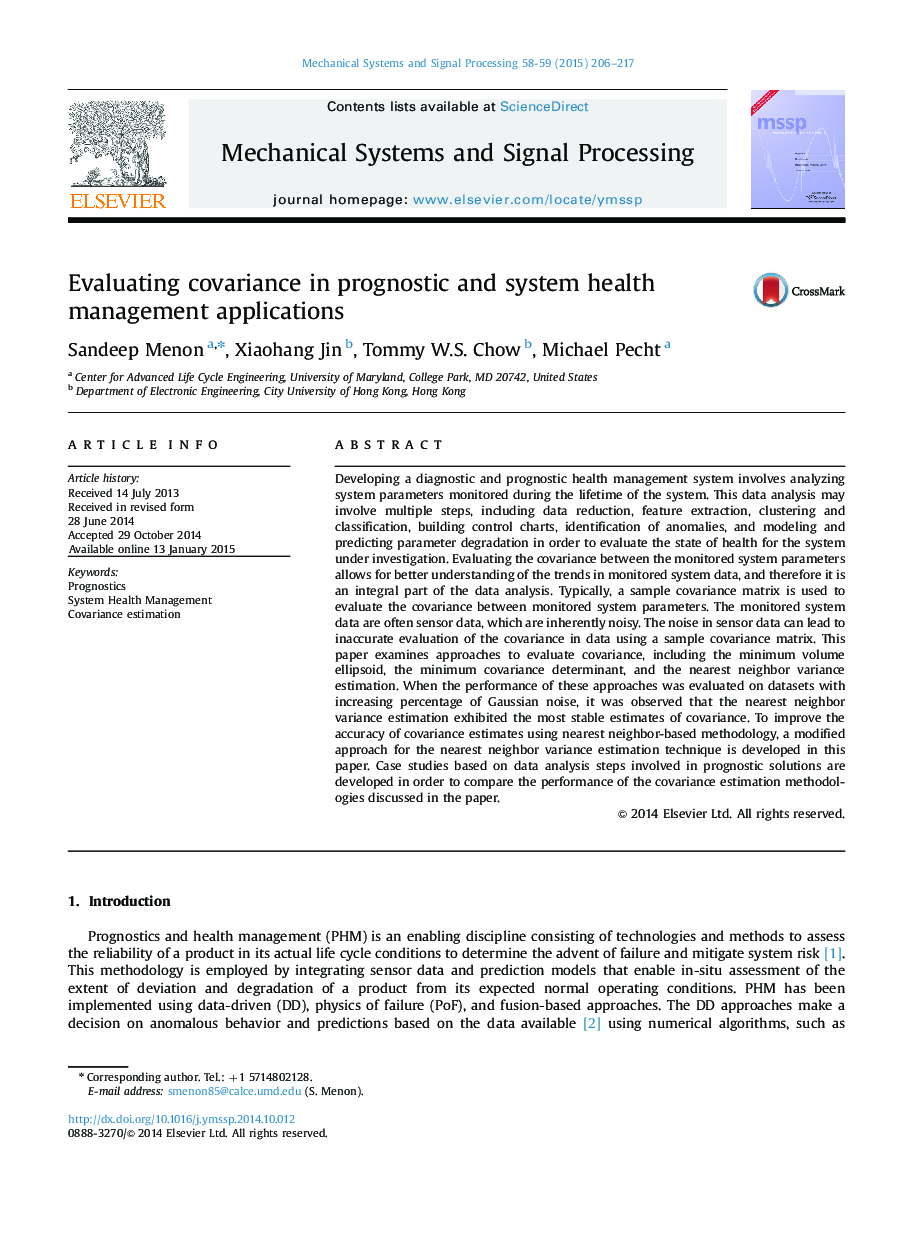| کد مقاله | کد نشریه | سال انتشار | مقاله انگلیسی | نسخه تمام متن |
|---|---|---|---|---|
| 6956038 | 1451865 | 2015 | 12 صفحه PDF | دانلود رایگان |
عنوان انگلیسی مقاله ISI
Evaluating covariance in prognostic and system health management applications
ترجمه فارسی عنوان
ارزیابی کوواریانس در برنامه های پیشگیری و سیستم مدیریت سلامت سیستم
دانلود مقاله + سفارش ترجمه
دانلود مقاله ISI انگلیسی
رایگان برای ایرانیان
کلمات کلیدی
پیشگیری، سیستم مدیریت بهداشت، برآورد کوواریانس،
ترجمه چکیده
در حال توسعه سیستم مدیریتی سلامت تشخیصی و پیش آگهی شامل تحلیل پارامترهای سیستم در طول عمر سیستم می شود. این تجزیه و تحلیل داده ها ممکن است شامل چندین مرحله شامل کاهش داده ها، استخراج ویژگی ها، خوشه بندی و طبقه بندی، ساخت نمودار کنترل، شناسایی ناهنجاری ها و مدل سازی و پیش بینی تخریب پارامترها برای ارزیابی وضعیت سلامت سیستم مورد بررسی باشد. ارزیابی کوواریانس بین پارامترهای سیستم مانیتورینگ اجازه می دهد تا درک بهتر از روند در داده های سیستم نظارت شده، و بنابراین آن بخشی جدایی ناپذیر از تجزیه و تحلیل داده ها است. به طور معمول یک ماتریس کوواریانس نمونه برای ارزیابی کوواریانس بین پارامترهای سیستم نظارت استفاده می شود. داده های سیستم نظارت شده اغلب اطلاعات سنسور هستند که ذاتا سر و صدا هستند. نویز داده های سنسور می تواند منجر به ارزیابی نادرست کواریانس در داده ها با استفاده از یک ماتریس کوواریانس نمونه شود. در این مقاله رویکردهای ارزیابی کوواریانس، از جمله حداقل حجم بلوری، حداقل متغیر کوواریانس، و تخمین واریانس نزدیکترین همسایگی بررسی شده است. هنگامی که عملکرد این روش ها در مجموعه داده ها با افزایش درصد صدای گاوسی مورد ارزیابی قرار گرفت، مشاهده شد که برآورد واریانس نزدیکترین همسایه، پایایی ترین ارقام کواریانس را نشان می دهد. برای بهبود دقت تخمینی کوواریانس با استفاده از روش نزدیکترین همسایه، یک روش اصلاح شده برای نزدیکترین روش ارزیابی واریانس همسایگی در این مقاله ارائه شده است. مطالعات موردی بر اساس گام های تجزیه و تحلیل داده ها درگیر در راه حل های پیش آگهی، به منظور مقایسه عملکرد روش های تخمین کواریانس مورد بحث در مقاله توسعه داده شده است.
موضوعات مرتبط
مهندسی و علوم پایه
مهندسی کامپیوتر
پردازش سیگنال
چکیده انگلیسی
Developing a diagnostic and prognostic health management system involves analyzing system parameters monitored during the lifetime of the system. This data analysis may involve multiple steps, including data reduction, feature extraction, clustering and classification, building control charts, identification of anomalies, and modeling and predicting parameter degradation in order to evaluate the state of health for the system under investigation. Evaluating the covariance between the monitored system parameters allows for better understanding of the trends in monitored system data, and therefore it is an integral part of the data analysis. Typically, a sample covariance matrix is used to evaluate the covariance between monitored system parameters. The monitored system data are often sensor data, which are inherently noisy. The noise in sensor data can lead to inaccurate evaluation of the covariance in data using a sample covariance matrix. This paper examines approaches to evaluate covariance, including the minimum volume ellipsoid, the minimum covariance determinant, and the nearest neighbor variance estimation. When the performance of these approaches was evaluated on datasets with increasing percentage of Gaussian noise, it was observed that the nearest neighbor variance estimation exhibited the most stable estimates of covariance. To improve the accuracy of covariance estimates using nearest neighbor-based methodology, a modified approach for the nearest neighbor variance estimation technique is developed in this paper. Case studies based on data analysis steps involved in prognostic solutions are developed in order to compare the performance of the covariance estimation methodologies discussed in the paper.
ناشر
Database: Elsevier - ScienceDirect (ساینس دایرکت)
Journal: Mechanical Systems and Signal Processing - Volumes 58â59, June 2015, Pages 206-217
Journal: Mechanical Systems and Signal Processing - Volumes 58â59, June 2015, Pages 206-217
نویسندگان
Sandeep Menon, Xiaohang Jin, Tommy W.S. Chow, Michael Pecht,
